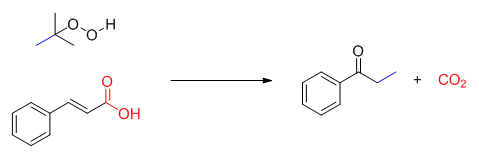摘要/Abstract

近年来,脱羧反应得到了广泛而深入的研究.肉桂酸类化合物的脱羧串联反应也得到了较多的关注.这类反应一般包括两个过程,自由基加成和羧基的脱去,从而在苯环的侧链引入各种各样的官能团.我们在研究过程中发现,在碳酸钾作为碱,过氧叔丁醇作为氧化剂,以二甲基亚砜(DMSO)/水作为混合溶剂条件下(体积比为1:1),肉桂酸类衍生物能够转化成苯丙酮类化合物.通过对反应机理的研究,产物中的甲基来自于过氧叔丁醇,反应经过自由基加成和进一步脱羧得到产物.该反应特点是没有用过渡金属盐作为催化剂,并且是在水相中反应,因此符合绿色化学的发展要求.
关键词: 脱羧串联反应, 甲基化, 苯丙酮类, 绿色化学
Decarboxylation reactions have been widely explored in recent ten years, and decarboxylative cascade reaction of cinnamic acids has also attracted much attention. Generally, this class of reaction includes two processes:radical addition and decarboxylation. The result of reaction can introduce kinds of functional groups on the benzene ring, such as halogen atom, nitro-group and trifluoromethyl. Following the continuous studies of our group on oxidative cascade reaction, especially the oxidative reaction in the absence of metal, herein we disclosed a decarboxylative oxidative cascade reaction of cinnamic acids under metal-free conditions. We employed K2CO3 as base, tert-butyl hydroperoxide (TBHP) as oxidant and DMSO/H2O as co-solvent, and cinnamic acids could be converted to propiophenone derivatives in moderate yield. To get an insight into the mechanism of this process, several controlled experiments were conducted. First, DMSO-d6 was employed under the standard conditions and no d-methyl was detected in the 1H NMR spectrum of product. It demonstrated that the methyl of product was derived from tert-butyl hydroperoxide. Subsequently, the reaction was carried out under nitrogen and oxygen atmosphere, and it was found that higher reaction efficiency was obtained in N2. The result indicated that methyl radical was easily quenched by oxygen. On the basis of experiment results, we proposed a plausible mechanism. First, tert-butyl hydroperoxide yielded methyl radical, then the reaction underwent radical addition and decarboxylation to generate the desired product. The reaction featured that tert-butyl hydroperoxide was used as oxidant and methylation reagent in this process, and the reaction proceeded under metal-free and aqueous phase condition. Therefore, it met the requirement of green chemistry. Meanwhile, the operation of reaction was also simple, for example, to a DMSO/H2O (0.5 mL/0.5 mL) solution of cinnamic acids (0.2 mmol) were successively added K2CO3 (0.3 mmol), TBHP (0.8 mmol). The reaction mixture was stirred at 100 ℃. Upon the completion, the desired product was purified by silica gel column chromatography.
Key words: decarboxylative cascade reaction, methylation, propiophenones, green chemistry
PDF全文下载地址:
点我下载PDF
